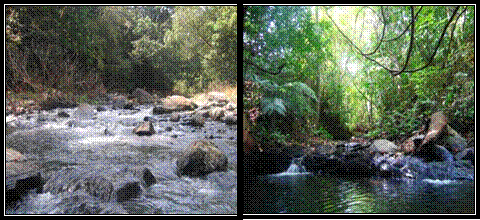Random opportunistic sampling of flora and fauna carried out in different habitats in Gundia river catchment (Figure 1 and 2) is listed in Table 1.
Table 1 : Sampling locations of biodiversity survey
Location |
° N |
° E |
Elevation |
Basappan kere |
12.76604 |
75.74252 |
907 |
Hongadahalla |
12.79995 |
75.71161 |
838 |
Aithalla |
12.77285 |
75.69973 |
804 |
Bettakumri halla |
12.77362 |
75.68271 |
779 |
Mogerahalli (Heradanahalli) |
12.81471 |
75.71136 |
756 |
Kempholé |
12.83262 |
75.65120 |
277 |
Kempholé stream |
12.83074 |
75.59398 |
184 |
Rare and unidentified specimens were collected for herbaria using dry method. Photographs were taken and geographical co-ordinates of occurrence using global positioning system (GPS) were noted. Fresh specimens were identified with the help of regional and other floras. Apart from primary data, we have also collected secondary data in terms of research papers published, interview and interaction with knowledgeable local people and scientists who earlier worked in the region. This helped in a better understanding of the ecological sensitiveness of the region.

Vegetation : The region inherits luxuriant forests, which can be divided broadly into the following types:
- Tropical wet evergreen to semi-evergreen rain forests : These were extensively found in most of the studied areas with a minimum to various amounts of disturbances. The canopy trees in these forests were over 30 m tall and covered with innumerable climbers and epiphytes. However, the canopy tends to be slightly open with no distinct stratification probably due to removal of old trees (Figure 2d). Some of the trees include Callophyllum apetalum, Lophopetalum wightianum, Dipterocarpus indicus, Myristica dactyloides, Gordonea obtusa, Artocarpus hirsutus, Canarium strictum, Garcinia talbotii, Bischopia javanica, Syzygium gardneri, Holigarma grahamii, etc. Huge trees of Vateria indica had a dominant presence in most of the places along with a large number of seedlings and saplings. Hanging and draping along the trees were climberssuch as Gnetum ula, Ancistrocladus heyneanus, Allophylus cobe, Rhaphidophora laciniata, Bauhinia phoenicea, etc.
- The riparian vegetation : Along the streams and rivulets, species such as Carallia brachiata, Madhuca neriifolia, Euonymus indica, Vateria indica, Calophyllum apetalum, Eleocarpus tuberculatus, etc. were found. In many places stream banks were dominated by reeds such as Cyperus pangorie, Ochlandra scriptoria, etc. Herbs such as Cryptocoryne retrospiralis, Dichanthium huegeli, Rotula aquatica, covered the sandy banks. Homonea riparia, Osmunda regalis, occurs scattered along the stream flow. Cyathea gigantea, occurs in shaded parts of the streams. Balanophora fungosa occurs as a root parasite on plants such as Euonymus indica, Syzygium sp, etc.
- Tropical wet deciduous forests : Occurred along more disturbed areas with species such as Careya arborea, Mallotus tetracoccus, Mallotus philippensis, Celtis sp., Aporosa lindleyana, Lagerstroemia lanceolate, Terminalia paniculata, etc.
- Scrub jungles: Most of the places surrounding the hilltops were scrub jungles with species such as Phyllanthus emblica, Careya arborea, Terminalia bellirica, etc.
- Grasslands and savannas : Most of the hilltops were grasslands with scattered shrubs of Wendlandia thyrusoide, Venguria spinosa, Canthium parviflorus, etc. Small stunted trees have orchids such as Trias stocksii, species of Oberonia, Dendrobium, etc.
Scattered trees along plantations and abandoned fields : Large areas of land are being under this type with many native lopped evergreen species standing scattered along the coffee plantations as shades for coffee plants. |


